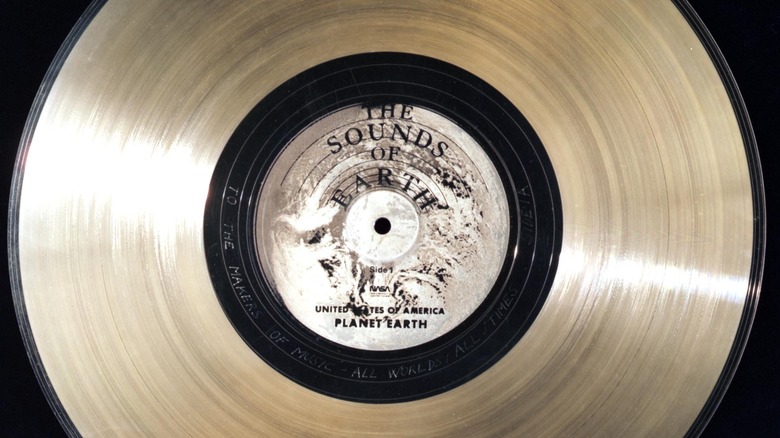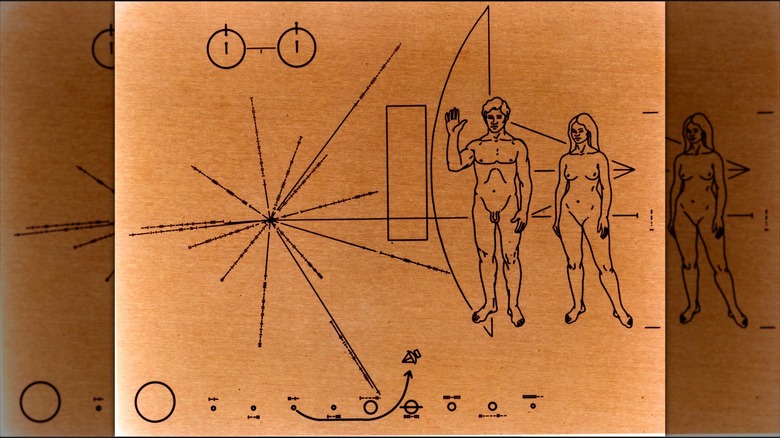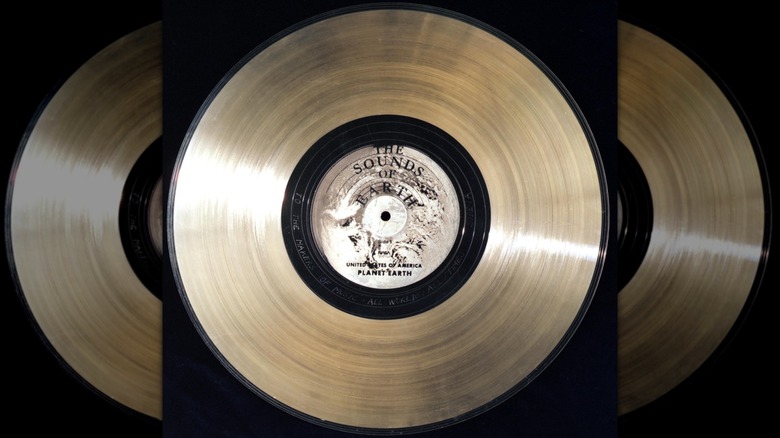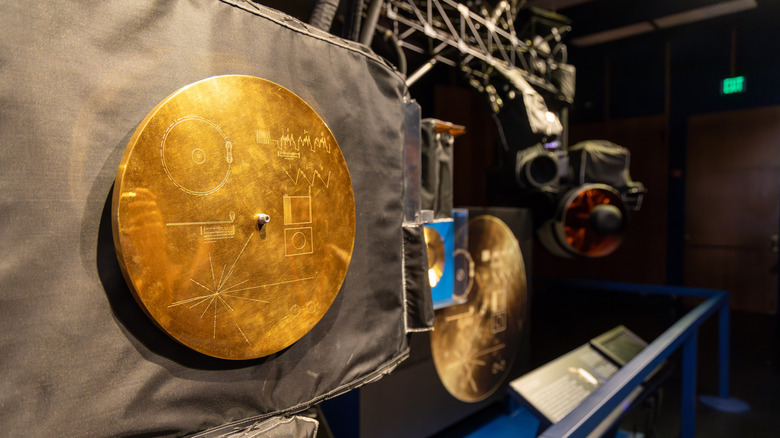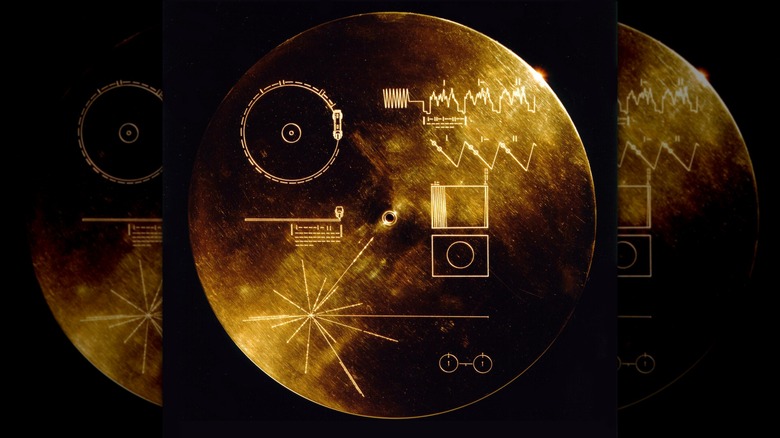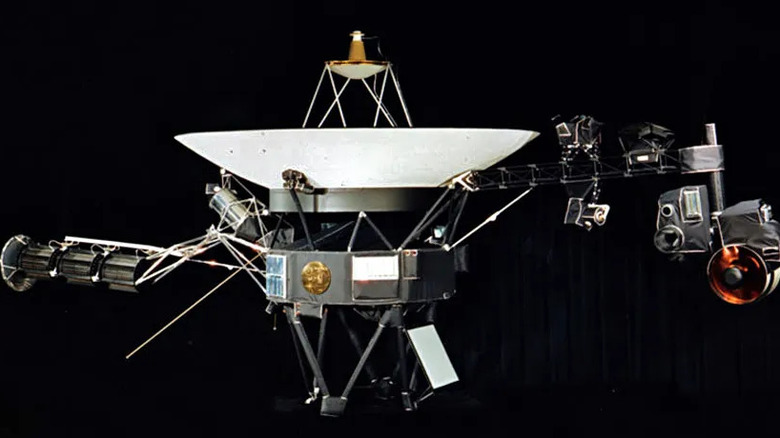What Is NASA's Golden Record, And What's On It?
In 1977, NASA launched the groundbreaking Voyager 1 and 2 missions into space. While both took off from Cape Canaveral, Florida, Voyager 2 began its journey sixteen days (August 20) before Voyager 1 (September 5). Their initial mission was to explore Jupiter and Saturn, which they did quite successfully, sending back data and images of Saturn's rings and Jupiter's moon Io.
Voyager 1 became the first human spacecraft to enter interstellar space in August 2012. Voyager 2 became the second in November 2018, delayed several years by its mission to investigate Uranus and Neptune. After 46 years, both are still screaming through the vastness of space, going "where no man has gone before." Their continuing mission is to explore the solar system's outermost edge, where the Sun no longer shines and, with a bit of luck — far beyond that.
As of this writing, Voyager 1 is over 15,142,815,696 miles from Earth, while its sibling is 12,649,771,917. This puts them closer to Pluto than the Sun and Earth. Since Voyager 1 is the farthest human-made object from Earth, and Voyager 2 is close behind, it's fitting that each carries a gold-plated record containing the sights and sounds of our home planet of Earth. Should they run into any extraterrestrial neighbors, the Golden Record is meant to identify what they are, where they came from, who sent them, and what humanity is all about.
The Pioneer Plaque
The idea for the Golden Record wasn't entirely original. In March 1972, NASA sent Pioneer 10 on its path toward Jupiter. It was the space agency's very first foray to reach one of the outer planets and eventually escape the solar system, so it was possible that if other space-faring civilizations existed, they might encounter it at some point.
Months before the launch, someone suggested to Carl Sagan (the space icon who influenced Neil deGrasse Tyson's whole life) that a message be attached to Pioneer's outer hull. At the time, Sagan was America's pre-eminent astronomer and science writer who had been advising NASA since the 1950s and was instrumental during the early days of the space program.
He, along with his then-wife and artist Linda Salzman Sagan and Cornell University Professor Frank Drake came up with "The Pioneer Plaque," which shows some basic math and science, the location of Earth within our galaxy, and a picture of a naked man and woman. A copy of this plaque (made from aluminum and dipped in gold) was also attached to Pioneer 11, which launched in April 1973.
NASA received Pioneer 11's last engineering data on November 24, 1995, and Pioneer 10's final signal on January 23, 2003, but both should still be zipping through space. If so, Pioneer 10 is headed to a star called Aldebaran in the Taurus constellation but won't get there for some two million years. Meanwhile, Pioneer 11 should reach the constellation of Aquila in about four million years.
Hopefully, math and science are universal
When it came time for the Voyager missions a few years later NASA wanted to go bigger. Rudimentary pictographs weren't enough; they wanted to tell a much broader story about humans and life on Earth. A committee was chaired by Carl Sagan, and using his experience in creating the Pioneer plaque, went to work figuring out the best way to convey that message.
During the creation of Pioneer's message, Sagan and his colleagues came to the conclusion that they needed to "speak" in a language that some distant cosmic civilization would understand. The Earth has approximately 7,000 spoken languages, all of which were created by humans based on human physiology. Extraterrestrials probably won't have the same body structure, and may not even "speak" at all because they might not have developed vocal chords or even ears to hear. So, using mathematics and science — presumably a universal constant throughout the cosmos — both were used as the base language.
When all was said and done the committee ended up with a 12-inch gold-plated copper disk that when played like a record emitted music, sounds, greetings (in 55 languages), and so much more. Included was a cartridge and needle so the record can be played at 16-2/3 revolutions per minute, and "To the makers of music – all worlds, all times" was etched onto the record in English by hand.
Sounds of Earth
The 27 music tracks chosen for the record come from numerous cultures and spanned the breadth and depth of eras. Everything from classical music by Bach, Beethoven and Mozart to rock ("Johnny B. Goode" by Chuck Berry) form the playlist. Selections from Mexico, Native Americans, Japan, Russia, Peru, and Aboriginal Australians were also added.
Twenty-one tracks come directly from nature and included sounds of wind, rain, and surf, all of which help provide context to the planet we live on. While noises made by animals in the wild, including crickets, frogs, birds, and elephants showcase the diversity of life on Earth. Human-created sounds, such as that of a tractor, Morse Code, automobiles, an F-111 flyby, and a Saturn 5 rocket (the technology that made the Apollo mission successful) lifting showcase our level of technology.
The most difficult category to add was the "Greetings to the Universe" recorded in 55 different languages. According to Linda Salzman Sagan, the committee decided to go with many different languages instead of just one or two because they felt it better represented Earth — one community with many parts — and acted like "an aural Gestalt, in which each culture is a contributing voice in the choir."
This process took hours of arduous work due to the obscurity of some of the languages and dialects. For instance, the section starts with a greeting in Akkadian, a language spoken in ancient Sumer six thousand years ago, and ends with the modern Chinese dialect of Wu.
Humans and animals and life on Earth, oh my!
NASA stamped 115 analog images onto the disk, including various types of planets, animals, landscapes, climates, and geography from around the globe. Additionally, there are several photos showing humans from various races doing things like running, working, eating, hunting, dancing, and a mother breastfeeding her child.
Images of the planets in the solar system, human anatomy, cells, DNA structure, chemical definitions, math equations, and diagrams that illustrate our understanding of space and science were also included. When the Voyagers launched, Jimmy Carter was the President of the United States, and Kurt Waldheim was the Secretary General of the United Nations, both of whom included printed messages. In fact, Waldheim issuing a verbal greeting on behalf of the people of Earth is the very first voice recording.
The record is protected by an aluminum cover electroplated with uranium-238. NASA did this because the half-life of U-238 is 468 billion years. If science and math are truly universal, then a space-faring race should be able to figure out how long it has been on the craft and approximately when it was launched.
NASA's message in a bottle
So, how would a far-flung extraterrestrial know what to do with this Golden Record? Instructions are engraved on the cover in a pictographic symbolic language along with binary-coded explanations illustrating how to play the record properly and extract the analog pictures from the recorded signals. For example, the upper left image is a circle representing the record. The included cartridge and needle sit on the outside edge of the disk. They show the correct position needed to play the record from the start, while binary code around the circumference of the album explains the proper record speed.
The images and code on the right side of the disk are associated with defining the video portion of the audio recordings, shows the general appearance of a waveform and that 512 vertical lines make up a complete picture. The two images on the bottom of the disk appeared on the plaques attached to the Pioneer probes. The one on the left shows the location of our sun with 14 pulsars emanating from it, with binary code defining the frequency of those pulses. The lower right image represents the hydrogen atom in its two lowest states. The line connecting the atoms has a number one under it to show how long it takes something to move from one state to the other and as a time scale used on the cover diagrams and in the decoded pictures.
